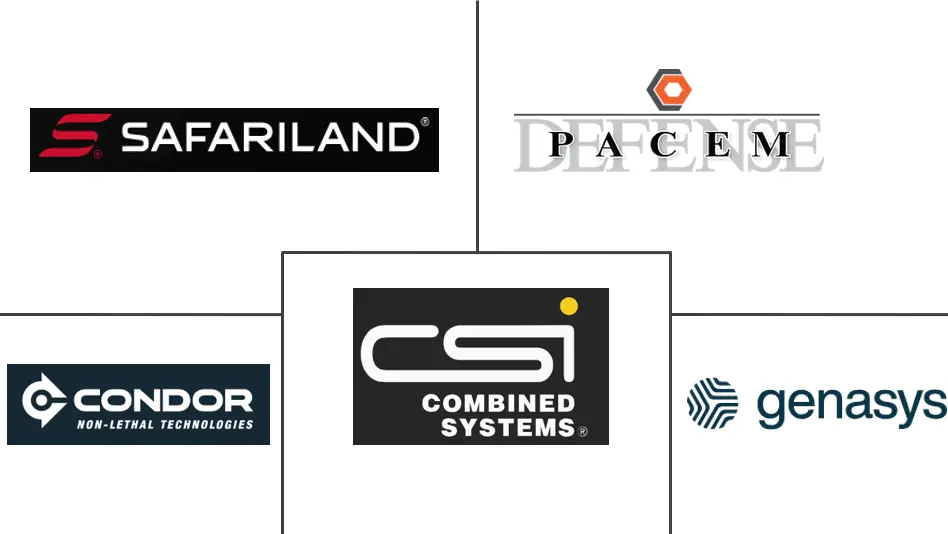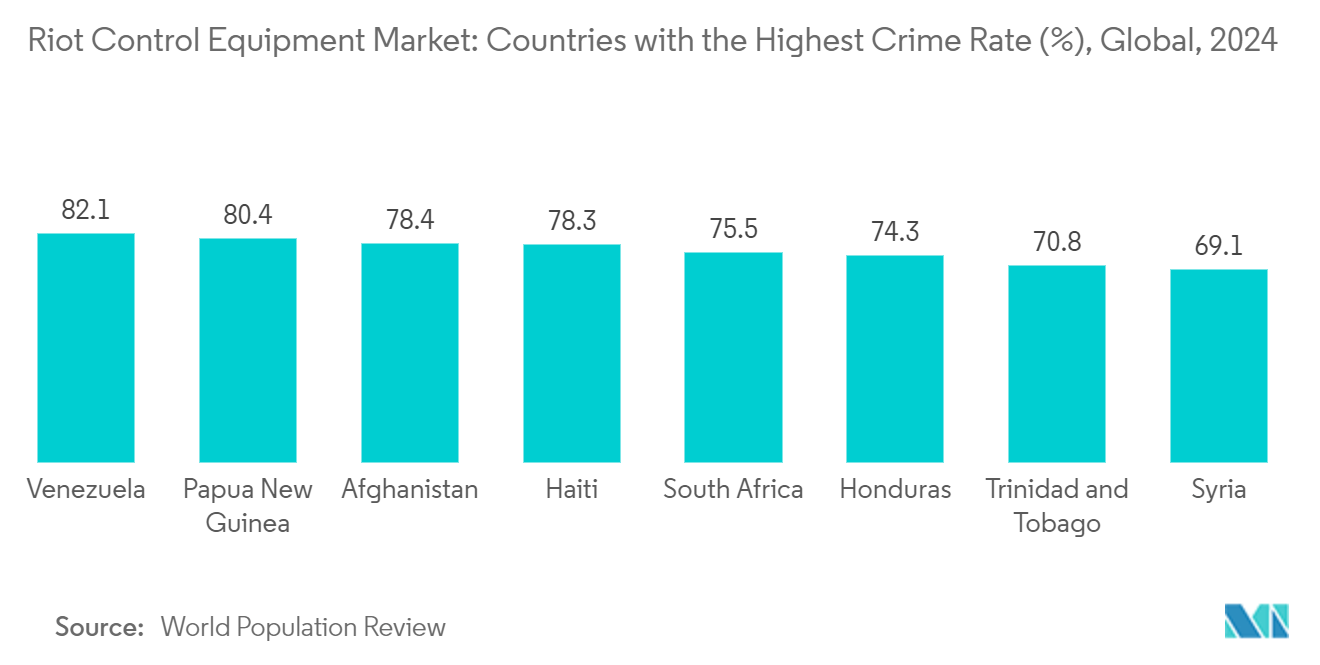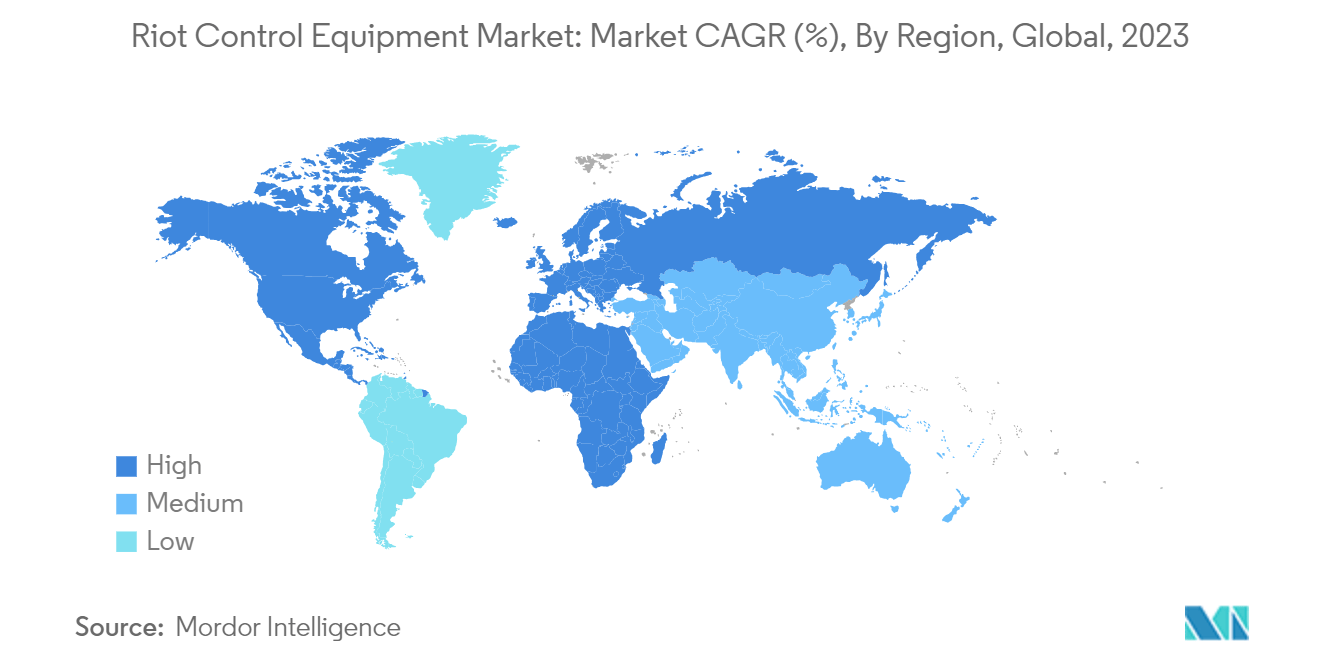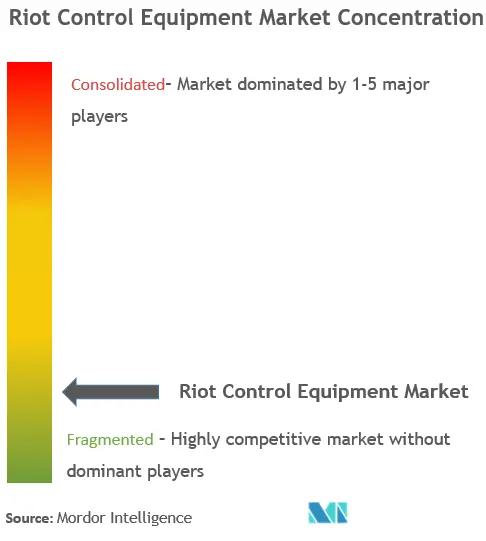Riot Control Equipment Market Size

| Study Period | 2019 - 2029 |
| Market Size (2024) | USD 12.06 Billion |
| Market Size (2029) | USD 15.29 Billion |
| CAGR (2024 - 2029) | 4.86 % |
| Fastest Growing Market | Europe |
| Largest Market | North America |
| Market Concentration | Low |
Major Players
*Disclaimer: Major Players sorted in no particular order |
Riot Control Equipment Market Analysis
The Riot Control Equipment Market size is estimated at USD 12.06 billion in 2024, and is expected to reach USD 15.29 billion by 2029, growing at a CAGR of 4.86% during the forecast period (2024-2029).
In recent years, there has been a surge in investments in advanced riot control equipment, primarily propelled by governments aiming to bridge gaps in their security apparatus. Over the past decade, Heightened mass demonstrations, street riots, and protests have underscored security vulnerabilities in North America and Europe. Consequently, the market is witnessing a flurry of procurement and development activities focused on cutting-edge riot control gear, setting the stage for robust growth in the years ahead.
Restrictions faced by the governments on deploying offensive riot control gear and the voice of concern raised by human rights organizations have hindered the widespread adoption of some equipment. There have been instances of serious injuries in countries due to inadequate training in equipment usage.
The next wave of riot control equipment is poised to harness technological advancements, replacing traditional gear with more effective, cutting-edge solutions. Notably, there is a pronounced emphasis on developing electroshock weapons, directed energy weapons, and advanced lightweight defensive gear, presenting lucrative growth avenues for market players.
Riot Control Equipment Market Trends
Vests Segment is Expected to Experience the Highest Growth
- Political disputes, civil unrest, and violence have surged in recent years, fueled by domestic and geopolitical factors. This has led to a landscape where many nations face a myriad of risks, from political instability to racial injustices, all against the backdrop of deepening polarization. Protests in several regions have spiked the demand for personal protective equipment, particularly vests. These vests, known by various names like body armor or personal armor, are crafted to absorb or deflect physical attacks. While historically the domain of the military, today, they find utility among a diverse range of users, including law enforcement, private security, and even civilians.
- Responding to this heightened demand, many nations are ramping up their procurement of bulletproof vests. Innovations like 3D printing and composite materials are poised to reshape the landscape of personal protective vests. For example, the MOBAST, groundbreaking body armor from Mehler Vario, can be comfortably worn under regular uniforms paired with ballistic innerwear, offering protection against low-energy shrapnel and blast elements. Notably, the MOBAST innerwear enhances coverage without adding excessive bulk. Highlighting the market's momentum, in September 2023, Ace Link Armor (United States) collaborated with Glágio do Brasil (Brazil) to introduce advanced ballistic protection to the US market. Their new NIJ-certified hard armor plate is designed to withstand high-powered rifle rounds, including the 7.62×51 M80, 5.56x45 mm M855, and 7.62x39 MSC. These advancements underscore the market's growth during the forecast period.

North America to Dominate the Market During the Forecast Period
- The United States, known for its frequent and large-scale riots, is a key driver of the regional market's demand for riot control equipment. Notably, in 2023, the United States witnessed a 20% surge in mass shootings compared to 2019, underscoring the escalating nature of this issue. This rise in shootings, a trend that has plagued the nation for decades, has put a strain on law enforcement, with reports of equipment shortages during crowd management. As a response, procurement of riot control equipment is anticipated to rise in the coming years. In anticipation, federal agencies have upped their inventories, stocking up on essentials like tear gas and sponge-tipped bullets. Moreover, the United States is actively engaged in R&D, focusing on developing advanced, less-lethal weapons and other riot control technologies.
- For example, the Pentagon's Joint Intermediate Force Capabilities Office (JIFCO), previously known as the Joint Nonlethal Weapons Directorate, collaborated with private arms companies in extensive testing. Their endeavors range from wireless taser bullets with extended ranges to sonic guns capable of disabling car engines from 150 feet away.
- Recent events further underscore the need for enhanced protective gear for law enforcement. In a notable incident in April 2024, Georgia police reportedly resorted to rubber bullets and tear gas to quell a university protest. Similarly, in December 2023, the Alpharetta City Council inked a five-year deal with Galls for concealable body armor. This contract, valued at an estimated USD 35,000 for FY 2024, will see police, reserves, and volunteer personnel equipped with concealable ballistic vests. The funding for this initiative is set to come from a USD 17,000 bulletproof vest grant from the US Department of Justice, supplemented by the FY 2024 uniform budget. These strategic investments and initiatives are poised to propel the market's growth in the United States over the forecast period.

Riot Control Equipment Industry Overview
The riot control equipment market is fragmented, with many players who supply different types of products, such as protective gear and non-lethal equipment. Some prominent players in the market include Condor Non-lethal Technologies, Safariland LLC, Genasys Inc., Combined Systems Inc., and PACEM Defense. Developing new protective equipment, like shields, vests, and helmets, with new materials that are lighter in weight and stronger may help the players gain market share. Moreover, the consolidation of the market, due to mergers and acquisitions of the market players, is expected to intensify the market competition.
Riot Control Equipment Market Leaders
-
Condor Non-lethal Technologies
-
Safariland, LLC
-
Combined Systems Inc.
-
Genasys, Inc.
-
PACEM Defense
*Disclaimer: Major Players sorted in no particular order

Riot Control Equipment Market News
- February 2024: Haryana Police became the first Indian police force to employ tear gas drones. These drones, crafted by Haryana's Drone Imaging and Information Service, were instrumental in dispersing protesting farmers at the Shambhu Barrier on the Punjab-Haryana border.
- January 2024: Wrap Technologies, headquartered in Arizona, unveiled its BolaWrap product, underscoring its non-lethal design. Resembling a taser, this device uses a Kevlar cord to restrain and temporarily restrict an individual's movement.
Riot Control Equipment Market Report - Table of Contents
1. INTRODUCTION
1.1 Study Assumptions
1.2 Scope of the Study
2. RESEARCH METHODOLOGY
3. EXECUTIVE SUMMARY
4. MARKET DYNAMICS
4.1 Market Overview
4.2 Market Drivers
4.3 Market Restraints
4.4 Porter's Five Forces Analysis
4.4.1 Bargaining Power of Buyers/Consumers
4.4.2 Bargaining Power of Suppliers
4.4.3 Threat of New Entrants
4.4.4 Threat of Substitute Products
4.4.5 Intensity of Competitive Rivalry
5. MARKET SEGMENTATION
5.1 By Product Type
5.1.1 Personal Protective Equipment
5.1.1.1 Vests
5.1.1.2 Helmets
5.1.1.3 Gas Masks
5.1.1.4 Shields
5.1.2 Offensive Equipment
5.1.2.1 Area Denial
5.1.2.1.1 Anti-vehicle
5.1.2.1.2 Anti-personnel
5.1.2.2 Ammunition
5.1.2.2.1 Rubber Bullets
5.1.2.2.2 Wax Bullets
5.1.2.2.3 Plastic Bullets
5.1.2.2.4 Bean Bag Rounds
5.1.2.2.5 Sponge Grenade
5.1.2.3 Explosives
5.1.2.3.1 Flash Bang Grenades
5.1.2.3.2 Sting Grenades
5.1.2.4 Gases and Sprays
5.1.2.4.1 Water Canons
5.1.2.4.2 Scent-based Weapons
5.1.2.4.3 Tear Gas
5.1.2.4.4 Pepper Spray
5.1.2.5 Directed Energy Weapons
5.1.2.6 Electroshock Weapons
5.1.2.7 Other Offensive Equipment
5.2 By End-User
5.2.1 Law Enforcement
5.2.2 Special Forces
5.3 By Geography
5.3.1 North America
5.3.1.1 United States
5.3.1.2 Canada
5.3.2 Europe
5.3.2.1 United Kingdom
5.3.2.2 France
5.3.2.3 Germany
5.3.2.4 Russia
5.3.2.5 Rest of Europe
5.3.3 Asia-Pacific
5.3.3.1 China
5.3.3.2 India
5.3.3.3 Japan
5.3.3.4 South Korea
5.3.3.5 Rest of Asia-Pacific
5.3.4 Latin America
5.3.4.1 Brazil
5.3.4.2 Rest of Latin America
5.3.5 Middle East and Africa
5.3.5.1 Saudi Arabia
5.3.5.2 United Arab Emirates
5.3.5.3 Israel
5.3.5.4 Rest of Middle East and Africa
6. COMPETITIVE LANDSCAPE
6.1 Vendor Market Share
6.2 Company Profiles
6.2.1 Combined Systems Inc.
6.2.2 Desert Wolf
6.2.3 Axon Enterprise Inc.
6.2.4 PACEM Defense
6.2.5 Genasys Inc.
6.2.6 Safariland LLC
6.2.7 NonLethal Technologies Inc.
6.2.8 Condor Non-lethal Technologies
6.2.9 Blackhawk
6.2.10 Etienne Lacroix Group
6.2.11 Lamperd Less Lethal
7. MARKET OPPORTUNITIES AND FUTURE TRENDS
Riot Control Equipment Industry Segmentation
Riot control equipment encompasses gear law enforcement, military, and security forces utilized to manage riots. Personnel protection gear ranges from body armor and riot shields to gas masks and vehicles. On the other hand, crowd dispersal equipment comprises rubber bullets, wax bullets, plastic bullets, bean bag rounds, batons, tasers, and sponge grenades.
The riot control equipment market is segmented by product type, end-user, and geography. By product type, the market is segmented into personal protective equipment and offensive equipment. By end user, the market is segmented into law enforcement and special forces. The report also covers the market sizes and forecasts for the riot control equipment market in major countries across different regions. For each segment, the market size is provided in terms of value (USD).
| By Product Type | ||||||||||||||||||||||||||
| ||||||||||||||||||||||||||
|
| By End-User | |
| Law Enforcement | |
| Special Forces |
| By Geography | |||||||
| |||||||
| |||||||
| |||||||
| |||||||
|
Riot Control Equipment Market Research FAQs
How big is the Riot Control Equipment Market?
The Riot Control Equipment Market size is expected to reach USD 12.06 billion in 2024 and grow at a CAGR of 4.86% to reach USD 15.29 billion by 2029.
What is the current Riot Control Equipment Market size?
In 2024, the Riot Control Equipment Market size is expected to reach USD 12.06 billion.
Who are the key players in Riot Control Equipment Market?
Condor Non-lethal Technologies, Safariland, LLC, Combined Systems Inc., Genasys, Inc. and PACEM Defense are the major companies operating in the Riot Control Equipment Market.
Which is the fastest growing region in Riot Control Equipment Market?
Europe is estimated to grow at the highest CAGR over the forecast period (2024-2029).
Which region has the biggest share in Riot Control Equipment Market?
In 2024, the North America accounts for the largest market share in Riot Control Equipment Market.
What years does this Riot Control Equipment Market cover, and what was the market size in 2023?
In 2023, the Riot Control Equipment Market size was estimated at USD 11.47 billion. The report covers the Riot Control Equipment Market historical market size for years: 2019, 2020, 2021, 2022 and 2023. The report also forecasts the Riot Control Equipment Market size for years: 2024, 2025, 2026, 2027, 2028 and 2029.
Riot Control Equipment Industry Report
Statistics for the 2024 Riot Control Equipment market share, size and revenue growth rate, created by Mordor Intelligence™ Industry Reports. Riot Control Equipment analysis includes a market forecast outlook to 2029 and historical overview. Get a sample of this industry analysis as a free report PDF download.



